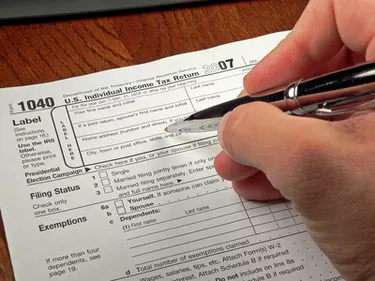
Out of every paycheck comes taxes, with federal withholding being one of them. While you can't do anything to adjust the amounts for the Social Security or Medicare payments, you do have the option of changing your federal withholding. The amount for federal withholding is calculated using the amount of total income and the number of exemptions you are claiming.
What is an Exemption?
Video of the Day
An exemption reduces your taxable income. Each taxpayer is allowed to claim one exemption in the filing of their taxes at the end of the year. If they are married filing jointly, they are allowed to claim theirs and their spouse's. For purposes of withholding, every employee is asked to fill out a W-4 form before beginning work. On that form they may claim as many exemptions as they choose, with the understanding that as exemptions increase the amount of withholding decreases. Doing this will increase take-home pay but may result in your owing more tax at the end of the year.
Video of the Day
How Much is Each Exemption?
For tax year 2012, the personal exemption amount was $3,800. This is the same amount for both types of exemptions. Sometimes the amount will increase based on law changes by the Congress. Those using the married filing jointly status will receive an exemption amount of $7,600. Each dependent will receive the same amount for her exemption as well.
Types of Exemptions
There are two main types of exemptions: the personal exemption and the dependent exemptions. A dependent is either a qualifying child or a qualifying relative. There are rules about the qualifications of these dependents; essentially, each dependent receives the same amount of exemption provided the income received doesn't exceed the limitations.
How to Claim Your Exemption
For those using the 1040EZ form, the exemption amount is combined with the standard deduction and entered on line 5. If you are using 1040A, add up the amounts in boxes 6a through 6d. Multiply $3,800 by the total in box 6d and enter that amount in line 26. If you are using the 1040, add up the amounts in boxes 6a through 6d and multiply $3,800 by that number entering the total on line 42.
Exemptions and Withholding
Because the amounts that are withheld are calculated using the total annual income of the taxpayer, it is important to make sure to have the exemptions correct. The amounts are withheld to ensure that you pay an adequate amount of taxes throughout the year. If you change the W-4 form (which you have every right to do) and increase the exemptions by even one, there won't be enough being withheld to pay the calculated taxes owed.
Unusual Exemptions
When a natural disaster strikes, such as Hurricane Sandy of 2012, sometimes extra exemptions are granted to those people affected by them. These unusual exemptions change every year based on whatever disaster has affected the most taxpayers that tax year.